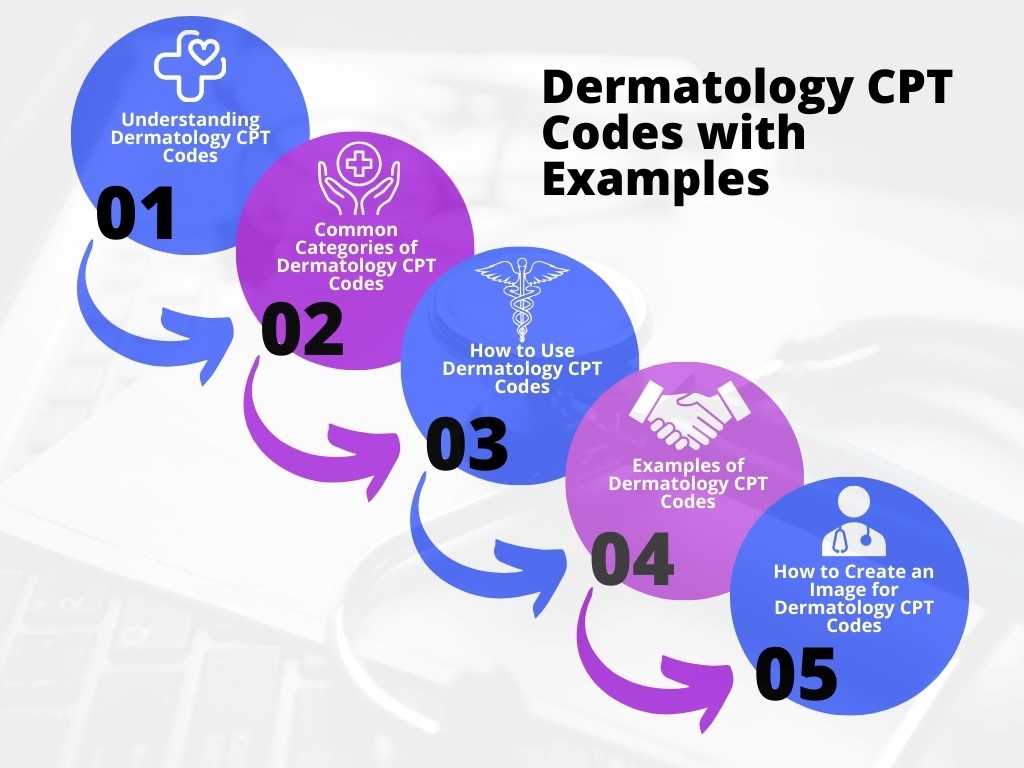Detailed Guide to Dermatology CPT Codes with Examples
CPT (Current Procedural Terminology) codes are used by healthcare providers to describe medical, surgical, and diagnostic services provided to patients. Dermatology CPT codes specifically pertain to procedures related to the skin, hair, and nails. These codes are essential for accurate billing and reimbursement.
Here’s a detailed guide to dermatology CPT codes, how to use them, and examples of their application:

1. Understanding Dermatology CPT Codes
CPT codes are divided into different sections:
- Evaluation and Management (E/M) codes
- Surgical codes
- Diagnostic tests codes
- Other specialized codes
Each section has codes tailored for specific dermatological procedures and services.
2. Common Categories of Dermatology CPT Codes
Evaluation and Management (E/M) Codes
- 99201-99205: New patient office visits (from basic consultation to complex problems).
- 99211-99215: Established patient office visits (used for follow-ups).
Example: A patient visits for a routine check-up; the provider might use 99213 (established patient visit, moderate complexity).
Surgical Codes
- 11400-11446: Excision of benign skin lesions.
- 11600-11646: Excision of malignant skin lesions.
- 17110-17111: Destruction of benign lesions via cryotherapy or electrosurgery.
- 11300-11313: Shaving superficial skin lesions.
Example: A basal cell carcinoma excision on the face may use 11604 (2.1–3.0 cm excision).
Dermatopathology Codes
- 88304: Level I – Dermatopathology examination.
- 88305: Level II – Detailed dermatopathology evaluation.
Example: Analyzing a biopsy sample might involve 88305.
Other Dermatology Codes
- 96900-96999: Phototherapy for skin disorders.
- 17260-17286: Chemical destruction of warts, lesions, or tumors.
Example: Phototherapy for psoriasis may use 96910 (UV light treatment).
3. How to Use Dermatology CPT Codes
- Proper Documentation: Document patient conditions and procedure details (e.g., lesion size, location).
- Code Based on Procedure: Select codes based on performed procedures (e.g., malignant melanoma excision: 11602).
- Consider Modifiers: Use modifiers for additional context (e.g., -50 for bilateral procedures).
- Use Diagnosis Codes: Pair CPT codes with ICD-10 codes for the condition (e.g., basal cell carcinoma: C44.119).
4. Examples of Dermatology CPT Codes
| Procedure | CPT Code | Description |
|---|---|---|
| New patient office visit | 99201-99205 | From basic to complex consultations |
| Established office visit | 99211-99215 | Follow-ups, varying by complexity |
| Excision of benign lesion | 11400-11446 | Simple to complex excisions |
| Malignant lesion excision | 11600-11646 | Malignant lesion removal |
| Shaving of skin lesions | 11300-11313 | Superficial lesion shaving |
| Phototherapy for psoriasis | 96910 | Ultraviolet light treatment |
| Cryotherapy for warts | 17110-17111 | Cryosurgical destruction of lesions |
5. Creating Images for Dermatology CPT Codes
To create an infographic:
- Use tools like Canva or Adobe Illustrator.
- Organize information into sections (e.g., E/M codes, surgical codes).
- Apply color coding and include examples for clarity.
Summary
Understanding dermatology CPT codes is crucial for accurate billing and healthcare management. Proper coding ensures reimbursement and effective communication across healthcare systems.




